- Author: Kathy Keatley Garvey
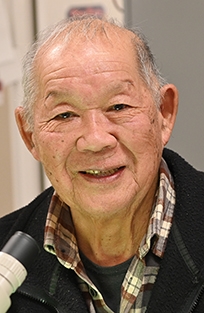
Kaya, who joined the UC Davis faculty in 1976 and retired in 2010, has known Lynn and her husband, Robert "Bob," for more than four decades. Both the Kimseys received their bachelor and doctoral degrees in entomology from UC Davis.
"I never had Lynn in a classroom situation, but she was always helpful in helping others ID insects," Kaya said. He and Lynn worked on a McKnight Foundation potato grant project in Peru for four years. He remembers Bob as a "super student in my insect pathology class."
Lynn, then Lynn Siri, received her bachelor's degree in 1975 and her doctorate in 1979, while Bob received his bachelor's degree in 1977 and his doctorate in 1984. Lynn joined the UC Davis faculty in 1989 and has directed the Bohart Museum since 1990. Bob, a forensic entomologist, joined the UC Davis faculty in 1984 as a lecturer. Both plan to retire this year.
Harry Kaya is internationally recognized for his contributions to insect pathology and insect nematology, which include more than 250 peer-reviewed publications. He co-authored an insect pathology book in 1993; co-edited another insect pathology book in 2012; and co-edited five books in several disciplines including forest entomology, entomopathogenic nematology, and invertebrate pathology.
He was named a fellow of the Entomological Society of America (ESA) in 2007.
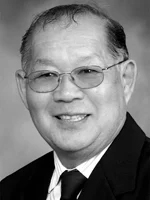
At the seminar, co-organizer Lynn Lebeck, then executive director of the Association of Natural Biocontrol Producers, praised him as a top-notch researcher and as "a warm human being." She recalled the "many years of fun times and great research experiences with him." (See news story)
Kaya co-founded the journal Biological Control, and served as the co-editor of the first and second editions of Field Manual of Techniques in Invertebrate Pathology, Application and Evaluation of Pathogens for Control of Insects and other Invertebrate Pests.
Born and raised in Honolulu, Harry received his bachelor's degree in entomology in 1962 from the College of Tropical Agriculture, University of Hawaii (UH). He served in the U.S. Army, and after being discharged as a first lieutenant, earned his master's degree in entomology from UH in 1964, specializing in insect ecology. In 1970, UC Berkeley awarded him his doctoral degree in entomology. with research in insect pathology.
From 1971 to 1976, Kaya worked as an entomologist at the Connecticut Agricultural Experiment Station in New Haven and conducted research on biological control of forest insects. In 1976, he joined the UC Davis faculty as an assistant professor, attaining the rank of full professor in 1984. He became a distinguished professor of entomology in 2008.
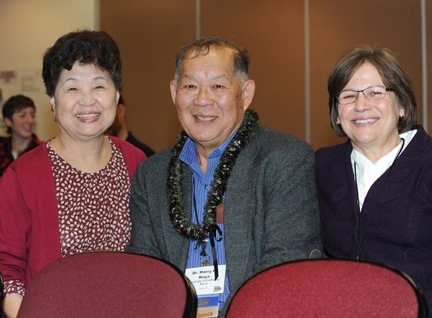
Kaya chaired the Department of Nematology from 1994 to 2001. He also served as an officer in the Society of Invertebrate Pathology (treasurer, 1990–1994, vice-president, 2000–2002, and president-elect 2002–2004), and was one of the founding editors of the journal Biological Control.
Highly honored by his peers, Kaya received the 1998 C. W. Woodworth Award, the highest honor presented by the Pacific Branch, ESA. In 2000, he received the 2000 Recognition Award in Entomology from ESA and Fellow of the Society of Nematologists. The Society for Invertebrate Pathology and UH also presented him with several awards.
In honoring him as a Fellow, ESA posted this on its website: "Kaya has mentored many graduate students and post-doctoral researchers who have proceeded to establish their own careers and excel in research and teaching. His laboratory hosted and trained many visiting scientists from other countries who have become leaders in research with entomopathogenic nematodes upon their return to their own countries. These include scientists from Korea, Thailand, Turkey, Mexico, Ukraine, and Peru. Kaya maintains a strong relationship with many of them and he had research projects with scientists from Korea and Turkey."
Kaya's first four PhD students--Raquel Alatorre, Arnold Hara, Phyllis Hotchkin {Weintraub) and Robin Goblin-Davis--are all retired from their faculty and research positions. Arnold Hara died Nov. 18, 2022.
Kaya resides in Davis with his wife, Joanna. He enjoys spending time with his grandchildren and gardening, and used to fish with colleague Les Ehler (1946-2016). "No fishing since Les passed away," he related.
One of his granddaughters, Madelyn Lee, a freshman at UC Riverside, may follow in his footsteps. "She has always been interested in the biological sciences and has become an active member of the Entomology Club at Riverside. She is thinking about being an entomology major."

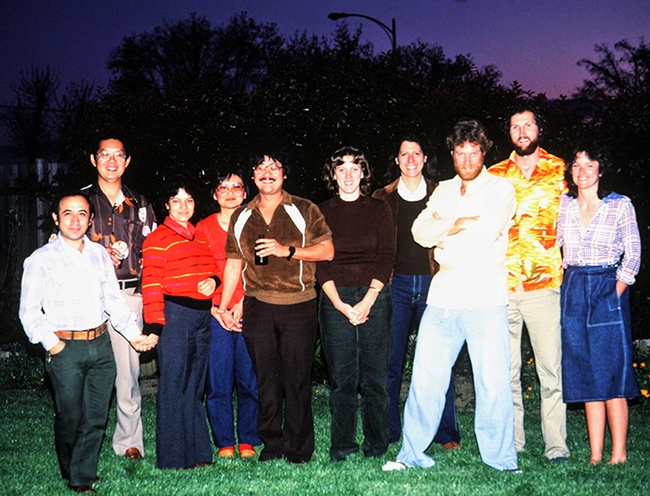
- Author: Kathy Keatley Garvey
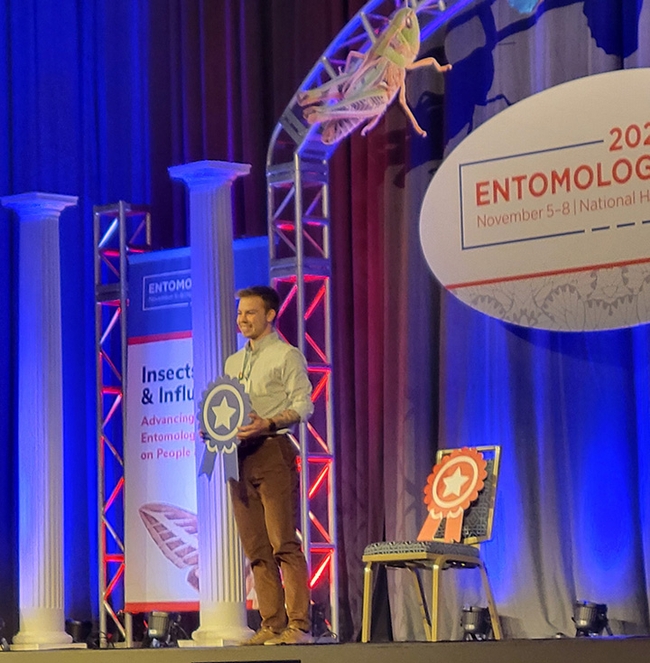
The top honors went to:
- Doctoral candidate Shawn Christensen and doctoral student Alexia "Lexie" Martin, both of the lab of associate professor and community ecologist Rachel Vannette, vice chair of the department; and
- Doctoral student Iris Quayle of the lab of professor and arachnologist Jason Bond, the Evert and Marion Schlinger Endowed Chair and associate dean, College of Agricultural and Environmental Sciences.
Christensen competed in the Plant-Insect Ecosystems (P-IE) Section, Apiculture; Martin in the P-IE Section, Pollinator Biology; and Quayle in the Systematics, Evolution, and Biodiversity (SysEB) Section, Biogeography.
Shawn Christensen. Christensen presented "Bee Specific! Solitary Bee (Anthophora bomboides) Hosts a Specialized Core Microbiome through Development."
His abstract: "Host-microbe interactions are important for the development and fitness of many macroorganisms. While social bees are dependent on a vertically transmitted gut microbiome, solitary bees, which comprise the vast majority of species diversity within bees, lack a specialized gut community. We explored the microbiome associated with the complete life cycle of the ground-nesting polylectic solitary bee Anthophora bomboides standfordiana, including bacterial and fungal composition and abundance. In contrast to expectations, we found that immature stages of this solitary bee maintain a distinct core microbiome consisting of Actinobacteria and one yeast species. Stage-specific shifts in microbial abundance and community composition occur most notably during bee diapause, during which the abundance of bacteria and fungi increased dramatically. We tested two adaptive hypotheses regarding the role of the microbiome in bee ecology. First, isolated brood cell Streptomyces strains were found to inhibit growth of multiple often pathogenic filamentous fungi, suggesting a role in pathogen protection during the long period of diapause. Second, sugar alcohol composition changed in tandem with major changes in microbial abundance suggesting links with bee metabolism or overwintering biology. Our results suggest that this Anthophora species hosts a conserved core microbiome that may provide key fitness advantages through larval development and overwintering. Much work remains to examine the nature of bee-microbiome ecology, but our study reframes the conditions thought to promote the evolution and maintenance of symbiosis."
Co-authors: Rachel Vannette and Sriram Srinivas, UC Davis; Quinn McFrederick, UC Riverside; Bryan Danworth, Cornell University; and Stephen Buchmann, University of Arizona
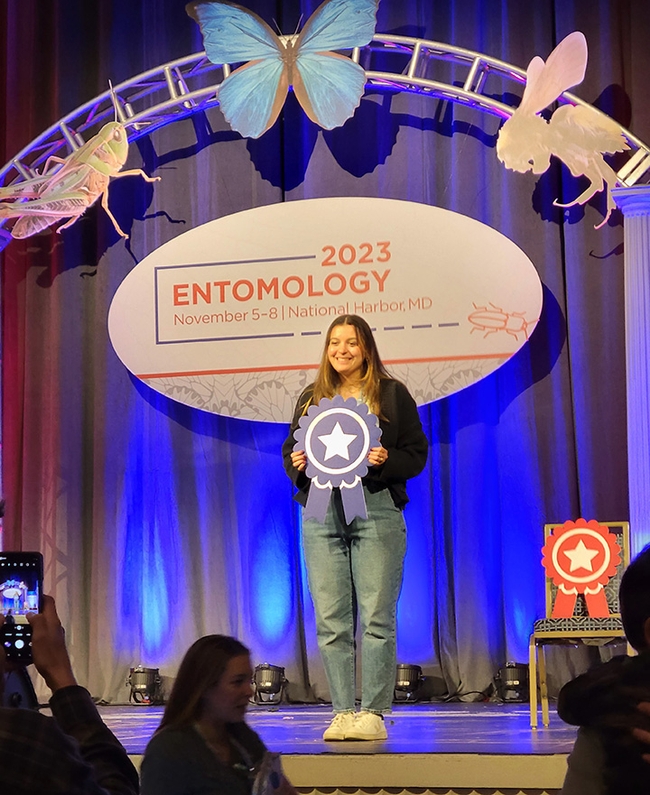
Her abstract: "Bees interact with and in some cases benefit from a diverse community of microbes, which can be obtained through intraspecific interactions or the environment. Due to differences in sociality, bee species vary in their main route of microbial acquisition and their dependence on microbes. Despite the observation that intraspecific transmission of microbes is imperfect and environmental microbes are nearly ubiquitous in flowers, the potential impacts of intraspecific versus floral microbes on overall pollinator health have not been evaluated. This study uses two model bee species - one social (Bombus impatiens) and one solitary (Osmia lignaria)--to assess the establishment and health impacts of floral and intraspecific microbes. 2x2 factorial experiments were performed on B. impatiens microcolonies and O. lignaria females to selectively introduce intraspecific microbes and/or floral microbes. Survivorship and reproduction were measured to assess bee health and fitness, and DNA extractions and amplicon sequencing were performed on bee guts to evaluate microbial establishment. The results of this study will inform how microbes from different acquisition routes establish in the host, shape the gut microbiome, and affect host health. Since many macroorganisms encounter both intraspecific and environmental microbes, this study provides a framework for similar work in other organisms."
Co-author: Rachel Vannette, UC Davis
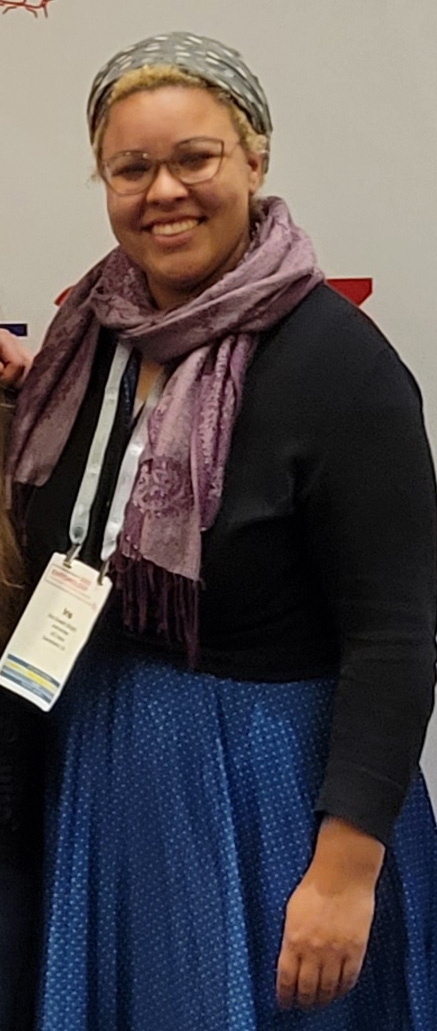
Her abstract: "In the Namib Desert, one of the largest and oldest deserts, the genus Onymacris contains a rarity for darkling beetles (Tenebrionidae) – the presence of eight species with striking ‘white' elytra (ranging from stark white to tan/striped). This study seeks to examine the phylogenetic relationships among white Onymacris species to test whether multiple derivations of white elytra is due to convergence or introgression. Population genomic data (3RAD) was generated from all white species of Onymacris with intraspecific sampling for four widespread species (O. marginipennis, O. bicolor, O. candidipennis, O. langi cornelii). Phylogenetic trees were inferred from 995 loci using concatenated and coalescent-based methods. The analyses supported two clades: langi and bicolor each of which contain species with pure white elytra. Variational autoencoder (VAE) clustering analysis shows a pattern of genetically isolated populations (bicolor) and gene flow indicating introgression (langi). These analyses also infer a potential new Angolan species sister to O. marginipennis in need of evaluation. Ancestral character state and biogeographic reconstruction resolve the timing of white species' color expression against the backdrop of sand sea emergence and increased aridity in the Namib, a landscape renown for ‘pocket speciation' and an impressive amount of darkling beetle diversity accounting for nearly 80% of the known endemic beetle fauna. Dynamic coloration provides a fascinating system through which to examine the role of ecological pressures and evolutionary mechanisms but requires a phylogenetic framework to understand organisms' potential adaptations to extreme environments, which is increasingly vital in the face of global trends aridity trends."
Co-authors: Lisa Chamberland, James Starrett and Jason Bond, UC Davis
The full list of student winners--first, second and third places--is here.
Founded in 1889, ESA is the largest entomological organization in the world. Its more than 7,000 members are affiliated with educational institutions, health agencies, private industry, and government.
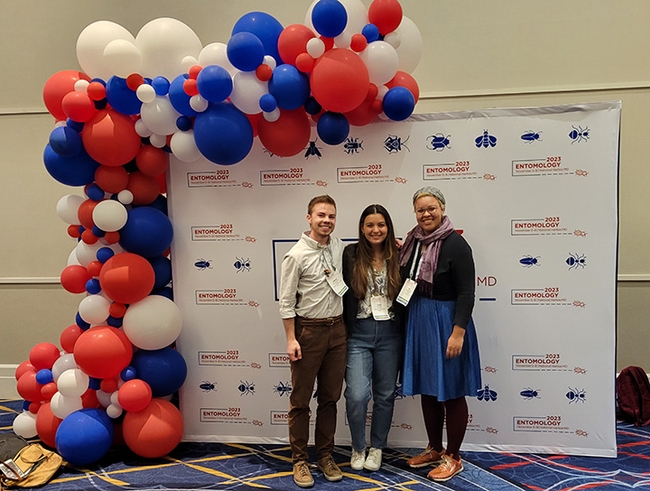
- Author: Kathy Keatley Garvey
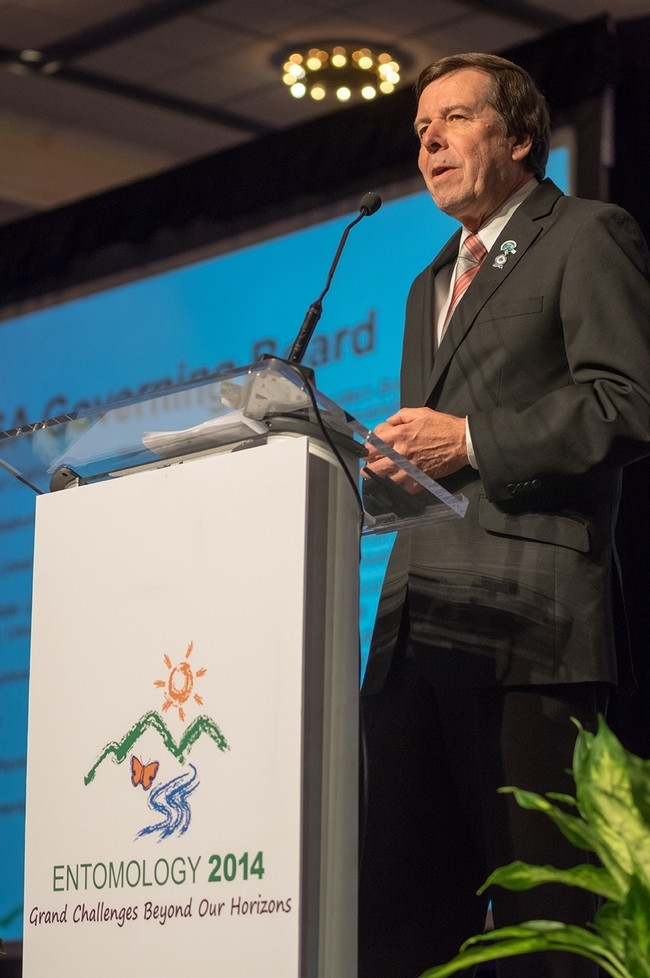
Theme of annual ESA meeting, taking place Nov. 5-8 at the Gaylord National Resort and Convention Center in National Harbor, Md. is "Insects and Influence: Advancing Entomology's Impact on People and Policy."
Among those participating is UC Davis distinguished emeritus professor Frank Zalom. A highly celebrated entomologist, Zalom is an ESA Fellow (2008), past ESA president (2014), and he holds ESA's highest honor, Honorary Member (2021), an honor achieved by only four other UC Davis entomologists: Harry Lange, 1990; Don MacLean, 1993; Bruce Eldridge, 1996; and John Edman, 2001. He continues his research as a recall professor.
Evolutionary biologist Scott Carroll and his wife, entomologist Jenella Loye, both research associates of the UC Davis Department of Entomology and Nematology and owners of Carroll-Loye Biological Research (CLBR) are also among the participants.
Carroll is the co-author of the newly published “Spatial Sorting Promotes Rapid (mal) Adaptation in the Red-Shouldered Soapberry Bug after Hurricane-Driven Local Extinctions” in the journal, Nature Ecology and Evolution that is drawing worldwide attention.
Officers of ESA, all women scientists, are:
- President: Marianne Alleyne, University of Illinois at Urbana-Champaign
- Vice President: Jennifer Henke, Coachella Valley Mosquito and Vector Control District
- Vice President-Elect: Lina Bernaola, Texas A&M University
- Past President: Jessica Ware, American Museum of Natural History
Founded in 1889, ESA is the largest entomological organization in the world. Its more than 7,000 members are affiliated with educational institutions, health agencies, private industry, and government.
"The premier event of the Society is its annual meeting. Each year approximately 3,500 entomologists and other scientists gather to exchange scientific information. A program of symposia, conferences, submitted papers, and continuing education seminars provides attendees the opportunity to hear and present research results. The meeting also provides a chance to interact informally with peers and prospective employers."--ESA website.
(Editor's Note: Access the ESA program and the list of UC Davis attendees (go to the online program at https://entomology2023.
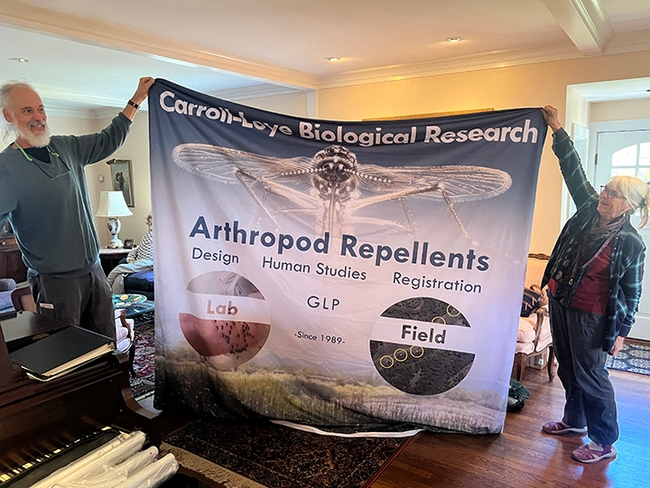
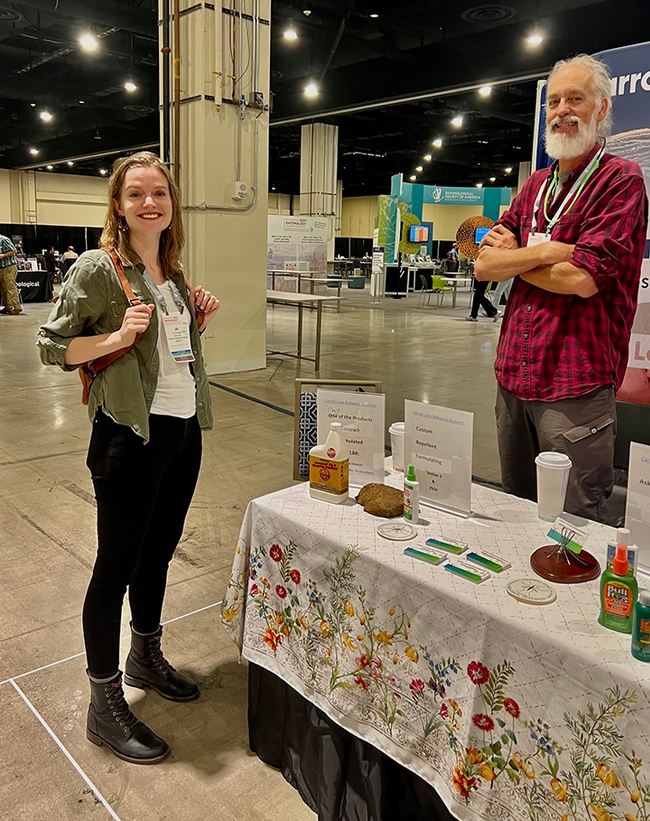
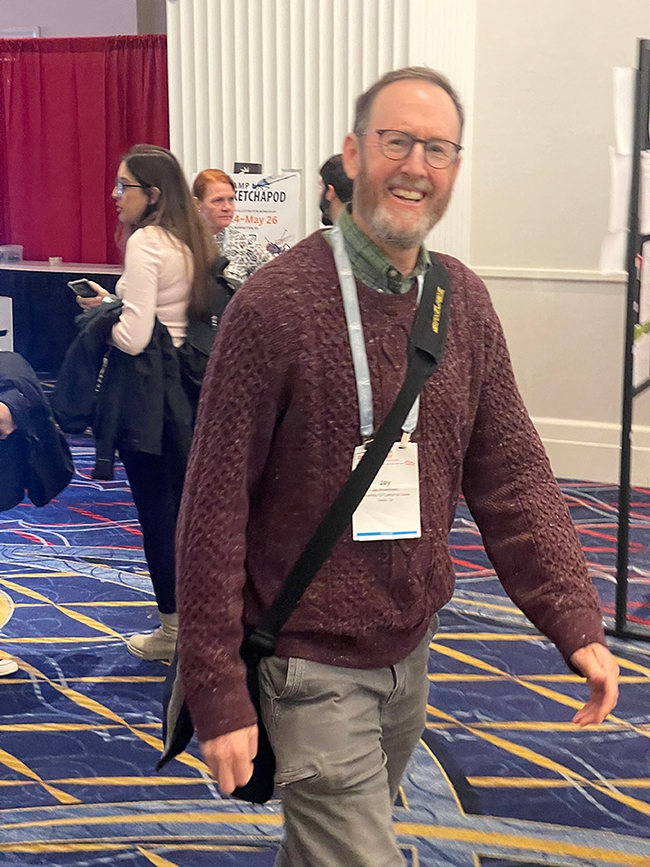

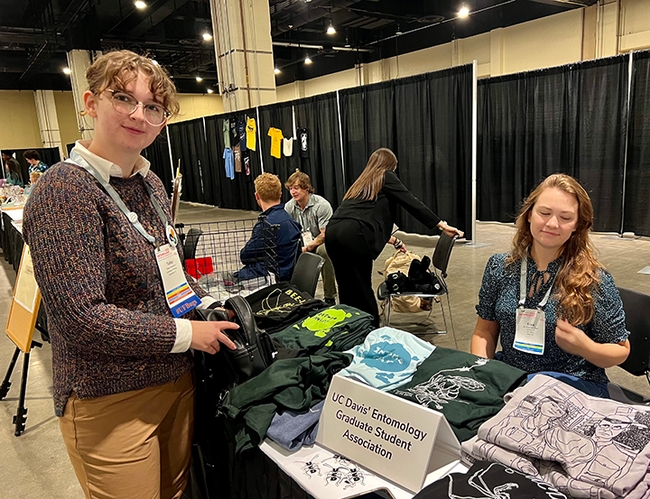
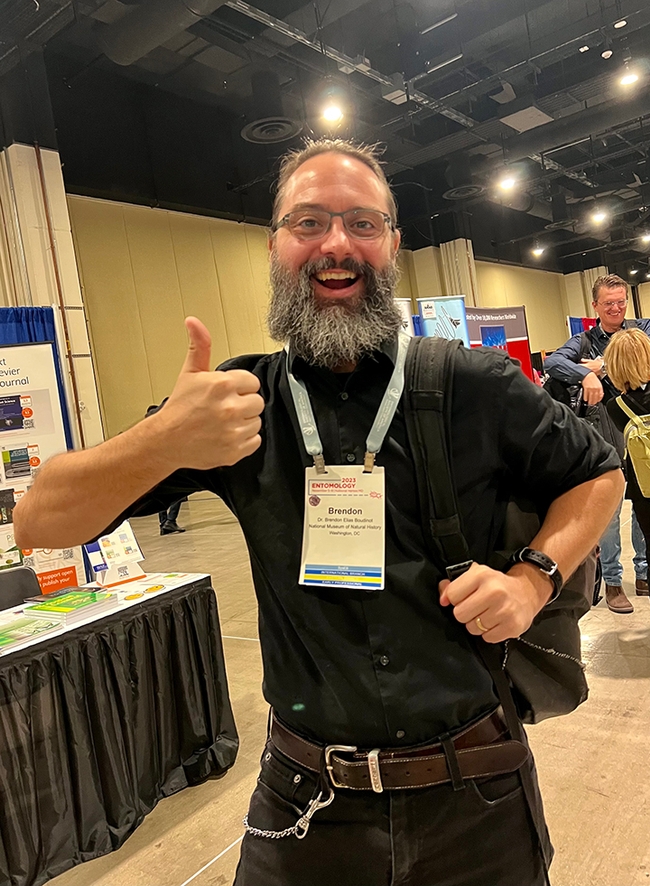
- Author: Kathy Keatley Garvey

"Walsh is known internationally for his research on the modes of action and resistance mechanisms of acaricides on spider mites and regionally in the Pacific Northwest for his extension and outreach efforts on specialty crops," ESA announced in a news release, citing that:
"Walsh has maintained a well-funded (more than $30 million) and productive program as the research director of the Environmental and Agricultural Entomology Laboratory located at the WSU Irrigated Agriculture Research and Extension Center in the Yakima Valley near Prosser, Washington. Walsh is the Extension integrated pest management (IPM) coordinator for Washington State and the Washington State liaison representative to the U.S. Department of Agriculture IR-4 Project."
"Walsh has an extensive and varied integrated pest and pollinator management research and Extension program assisting regionally important commodities including hops, alfalfa, grapes, and mint. Walsh also directs environmental impact studies on alfalfa leafcutting and alkali bees, the key pollinators of alfalfa produced for seed. Walsh's efforts in IPM have resulted in the documented reduction of over 100,000 pounds of insecticide use in the Pacific Northwest annually."
Born in New York in 1963 and a resident of California since 1969, Walsh holds a bachelor's degree in biology from UC Santa Cruz (1985). He received his doctorate in entomology from UC Davis in 1998, studying with major professor Frank Zalom, who went on to become a UC Davis distinguished professor and president and Honorary Member of ESA. "He is very deserving," Zalom said. "I couldn't be more proud of all that he has accomplished."
Said Walsh: "I was Frank's first PhD student. Frank had one before me, Rachid Hanna. Frank picked up Rachid when Rachid was orphaned when his original professor left UC Davis. Rachid and I quibble about who was Frank's first student. I'm the first that went from start to finish with Frank."
"(Professors) Sean Duffy and Harry Kaya were also on my PhD committee," Walsh said.
Kaya remembers Walsh well. "He was studying integrated pest management at UC Davis and was an outstanding graduate student in Frank Zalom's lab," Kaya said. "Even as a graduate student, he published some significant papers on IPM research, and I had no doubt that he would excel in research in his post graduate years. He has not only done superb IPM research but has been a leader in the Entomological Society of America as well as other national and international organizations. He richly deserves being elected as an ESA Fellow."
Walsh, Zalom and Dean Helene Dillard of the UC Davis College of Agricultural and Environmental Sciences, then Extension director at Cornell, spent three weeks together on a USDA-sponsored agricultural extension tour of China.
Walsh joined the WSU Department of Entomology as assistant professor in 1998 and advanced to associate professor in 2003 and to professor in 2007. The author of more than 200 publications, he annually delivers more than 35 Extension presentations. He has mentored 12 doctoral students and 11 master's degree students.
Walsh served as president of the Pacific Branch of ESA (PBESA) in 2010 and represented PBESA on the ESA governing board from 2013 through 2019. Among his ESA awards: Excellence in IPM Award and he led two teams that received the IPM Team Award.
Walsh's WSU awards include the Sahlin Award for Outreach and Engagement, the Excellence in Extension Award, the Team Interdisciplinary Award, and the Excellence in Integrated Research and Extension Award.
For his work in the hops industry, the International Hop Growers Bureau knighted him into of the Order of the Hop (Chevalier) in 2017.
A WSU news story (Sept. 7, 2023) related that Walsh has "worked primarily on pest control issues, mostly on hops, grape vines, mint, and alfalfa. One of his first successes at WSU in 2005 involved developing a novel method for controlling cutworms, which climb up from the soil in spring to nibble on grapevine buds."
Walsh initially set out to become a botanist. “I was working in a local Extension office in California after I got my bachelor's degree," he told the WSU writer Scott Weybright. "That work involved battling spider mites on strawberries. I kind of fell into entomology, but I love the work and the creative solutions we find to help growers."
Another reason he wanted to become an entomologist: job security. He told Weybright that there are five-to-ten entomology jobs for every botany job. “We as humans are very efficient at moving pests around,” Walsh added. “There is always going to be a new pest and a need for someone to figure out how to best fight it.”
His wife, Catherine (Kikie) is a senior software engineer with Altera Digital, a hospital software firm. The couple, married 35 years, raised three children, Claire, Russ, and Jeff, all WSU grads. Claire is the lifecycle marketing manager with Niantic Labs; Russ is working toward his master's degree in teaching at WSU Tri-Cities: and Jeff is a site reliability engineer at TikTok.
Others named 2023 ESA Fellows are:
- Cassandra Extavour, Harvard University
- James Hagler, U.S. Department of Agriculture-Agricultural Research Service
- Alvin M. Simmons, U.S. Department of Agriculture-Agricultural Research Service
- Lukasz Stelinski, University of Florida
- Edward L. Vargo, Texas A&M University
The six will be honored during Entomology 2023: Insects and Influence: Advancing Entomology's Impact on People and Policy, set Nov. 5-8, in National Harbor, Md.
ESA, founded in 1889, is a worldwide organization of more than 7000 members, who are affiliated with educational institutions, health agencies, private industry, and government. Members are researchers, teachers, extension service personnel, administrators, marketing representatives, research technicians, consultants, students, pest management professionals, and hobbyists.
Resources:
- A Career Battling Pests Leads to National Honor for Scientist (Sept. 7, 2023, Washington State University)
- WSU Showcase Award, YouTube, 2017
- ESA's 2023 Fellow Awards, Entomological Society of America.
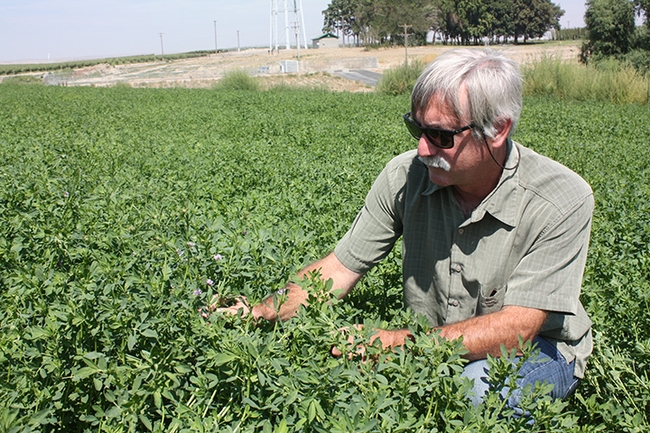
- Author: Kathy Keatley Garvey
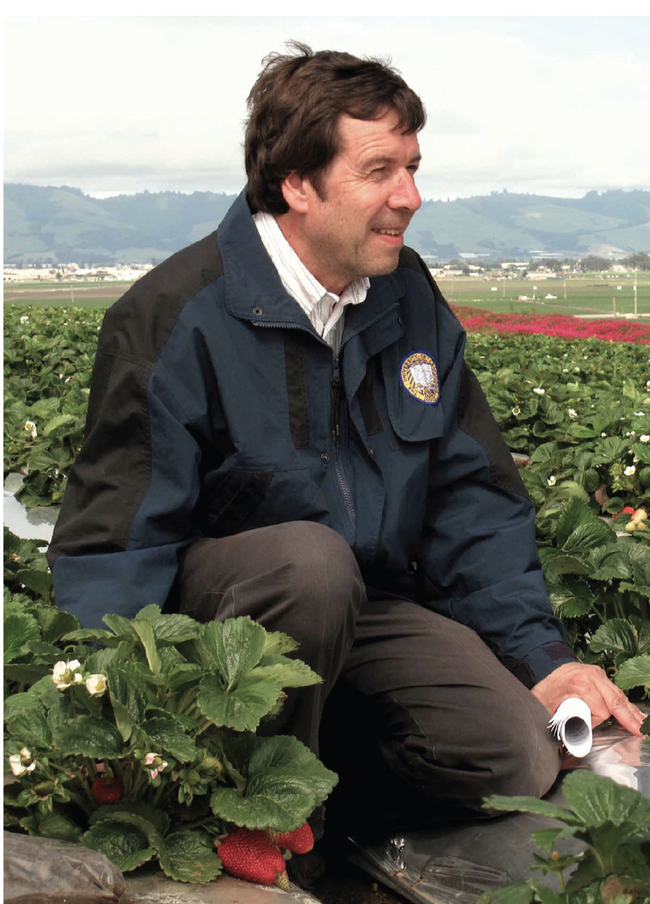
The UC Davis distinguished professor emeritus, an icon in the entomological world, especially in integrated pest management (IPM), grew up thinking that he might be working for the telephone company.
His father, an immigrant from Czechoslovakia, wanted him to obtain a college degree and pursue “a career with the telephone company,” Frank related. “Both of my parents worked for Western Electric, a part of AT&T.”
That proposed career did not happen. When he enrolled at Arizona State University, Frank chose to major in architecture before switching to zoology.
“In high school, I really liked mechanical drawing, and I was pretty good with math,” he told interviewer Marlin Rice on Feb. 14 for a Legends feature appearing in the summer 2023 issue of the American Entomologist, a publication of the 7000-member Entomological Society of America (ESA). “In 1970, there was the first Earth Day, and I got caught up in that. I wanted to do something to save the world from pollution and overpopulation. I became really interested in environmental issues. That's when I switched to zoology. At Arizona State, we collected scorpions for their anti-venom lab, and they would pay us a quarter a scorpion.”
Frank received two degrees from Arizona State, a bachelor's degree in zoology (1973) and a master's degree in ecology (1974), before earning his doctorate in entomology in 1978 from UC Davis, where he studied with major professor and agricultural entomologist Albert “Al” Grigarick.
“Frank was working for the U.S. Forest Service in Davis when he applied for graduate school in entomology,” Grigarick, now 95, said in an interview July 10. “When his application was circulating among our faculty for a major professor, I noticed his thesis was on a backswimmer. With a background in aquatic entomology, I wondered if he might be interested in doing research in our California rice fields. He did, was an excellent graduate student and soon got his PhD. He accepted an academic position at the University of Minnesota (assistant professor, 1979-1980, in the Department of Entomology, Fisheries and Wildlife) but the climate there may have played a role in his decision to apply for an IPM position in Cooperative Extension in California. I applaud the selection committee that accepted him. The University of California, California Agriculture, and the discipline of entomology have received countless benefits from his pursuits. I am very proud of Frank.”

A highly celebrated entomologist, Zalom is an ESA Fellow (2008), past ESA president (2014), and he holds ESA's highest honor, Honorary Member (2021), an honor achieved by only four other UC Davis entomologists: Harry Lange, 1990; Don MacLean, 1993; Bruce Eldridge, 1996; and John Edman, 2001.
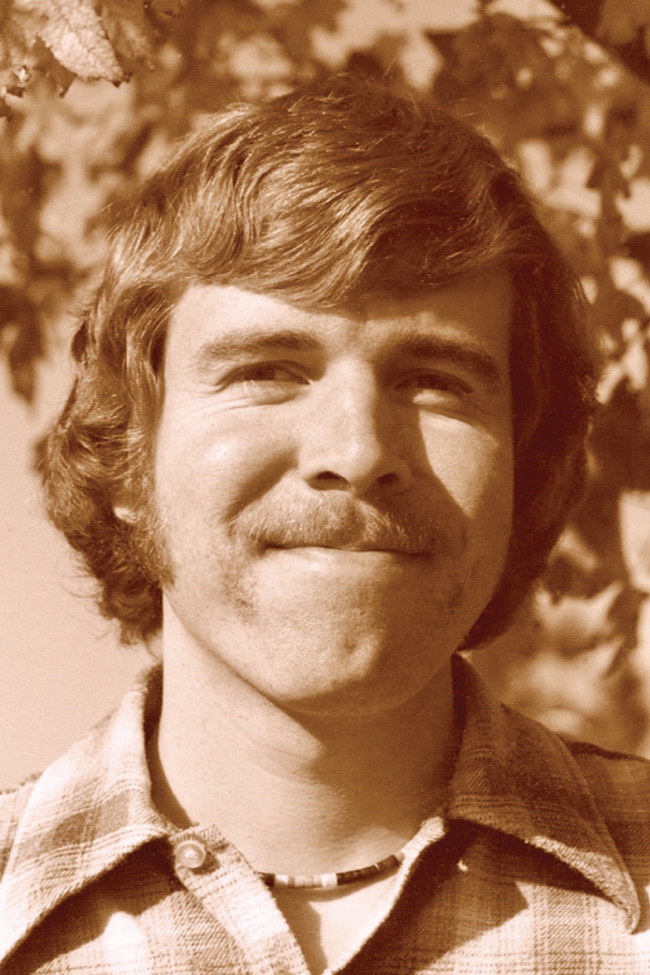
Zalom considers himself a “blue-collar entomologist.” As he told Rice: “That's the way I consider myself: somebody that doesn't mind getting dirty, who's interested in insects, likes to communicate with people, and wants to solve problems.”
Rice's article, Frank Zalom, Blue Collar California, is one of a series in his “Legends: Life Stories from Legends in Entomology” feature that highlights the careers of noted entomologists who are at least 70 years old and remain active professionally. Zalom is the second UC Davis entomologist to be featured in Legends. Rice chronicled the life and work of UC Davis Distinguished Professor Bruce Hammock in the spring 2020 edition.
“I am honored to follow Bruce as the second member of our department featured in this American Entomologist column,” Zalom said. Among his scores of credentials: Fellow of the Royal Entomological Society (2015), Fellow of the American Association for the Advancement of Science (2010),and the author of 376 journal articles or book chapters. (See Zalom's full CV on his website at https://entomology.ucdavis.edu/people/frank-zalom). He recently completed a 4-1/2 year term as Editor-in-Chief of ESA's Journal of Economic Entomology.
Zalom retired from the university in 2018 as a distinguished professor emeritus, but immediately joined the “recall professor” ranks.
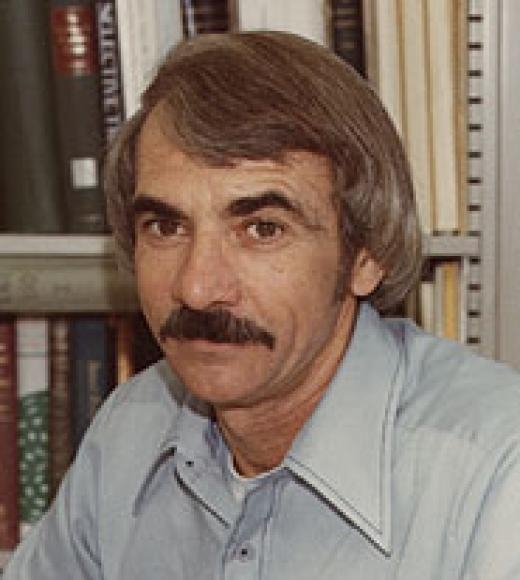
“Beginning in 1980 and continuing through today, Zalom has focused his extension and research activities on California specialty crops, including tree crops, small fruits, and fruiting vegetables,” Rice wrote. “The IPM strategies and tactics Zalom has developed include monitoring procedures, thresholds, pest development and population models, biological control, cultural control, and use of less toxic pesticides, which have become standard practice and part of the University of California IPM guidelines for these crops.”
Rice added: “The Zalom lab has responded to numerous newly identified or invasive pests in the last two decades, with research projects on glassy-winged sharpshooter, olive fruit fly, a new biotype of greenhouse whitefly, light brown apple moth, grapevine red blotch disease, brown marmorated stink bug, and spotted-wing drosophila, among others.”
Some excerpts from the American Entomologist article, as shared by Rice:
What was your first memorable experience with an insect?
“I was raised in Arizona, and it may have been when I was six or seven years old. We had very sandy soils, and we'd see cone-shaped pits with an antlion in the bottom. We'd drop other insects in there for them to grab. That was the first time I ever thought much about insects.”
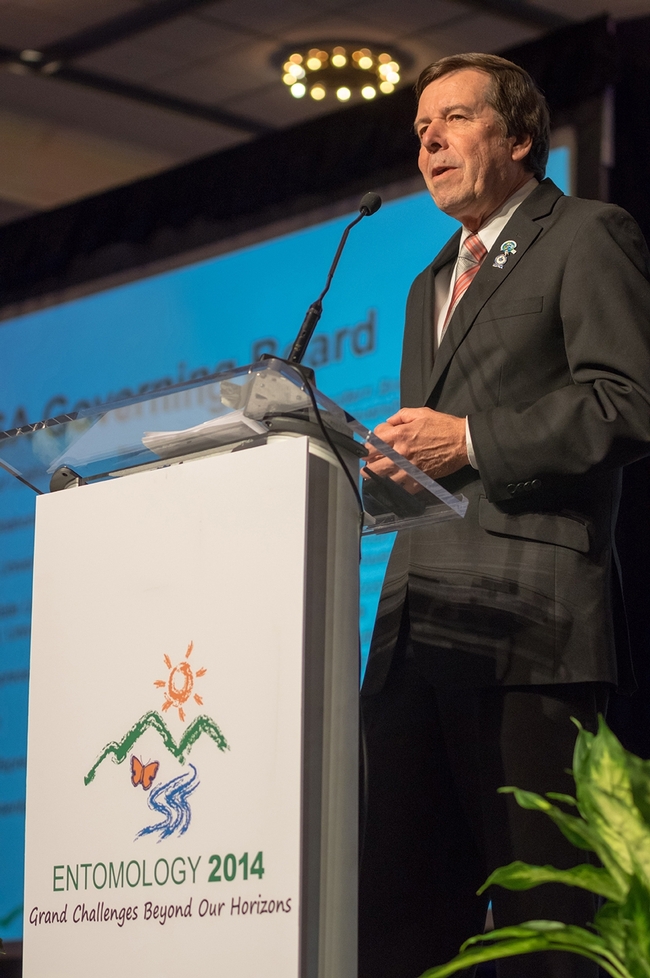
“In those days, there were a lot of required ‘-ology' type classes. I took general entomology, taught by Frank Hasbrouck. I did well in the class and thought it was interesting. Another class I took was aquatic insects; that was taught from an ecology perspective. I liked working with insects, but I never imagined I would do anything related to entomology when I finished. I also did a summer job at the USDA cotton lab in Phoenix, working with their sterile male release program and sweeping cotton fields for pink bollworms. I did it for a job, but I learned more about research.”
What was your greatest challenge as an undergraduate or graduate student?
“Just to figure out where I would be going with a career. I always had this ‘working for the telephone company' mentality, which I did not want to do. If you don't come from an academic background, you only associate professional jobs with doctors, lawyers, teachers, and teaching was something I knew I could do. As I started to mature academically, I realized there's a whole world out there I wasn't aware of. More things than being a doctor, lawyer, or teacher.”
You are officially retired but still working as a recall professor. When I hear the word ‘recall,' I think of something that is broken or not functioning correctly, like an automotive part. I assume that's not what recall means here?
“No, although there are days when I feel like I am not quite functioning properly. At UC, you can get recalled and paid part-time, and in my case, it allows me to keep my lab and most importantly to stay active in research. The funding comes from the California Department of Food and Agriculture primarily for consulting on pesticide uses, alternatives, and impacts of proposed regulations. This is helpful for the state because I have a solid understanding of pests and pest management in California crops, and I have established a good deal of mutual trust and understanding with growers' groups. In this role, I can impact pesticide policy and help maintain some of the most critical chemical uses.”
What is your philosophy of extension?
“It's about putting your foot in the other person's shoes. I try to understand the grower's perspective and needs, then approach the job like problem solving. Although I've always tried to reduce the negative impacts of pesticides, I also work towards implementable alternatives. The growers appreciate it. They know I'm not trying to take the pesticides from them without offering an alternative. That was a concern from the ag industry early in the UCIPM program, which was funded by the state legislature to reduce pesticide use, and the growers were worried that it would contribute to more regulation.”
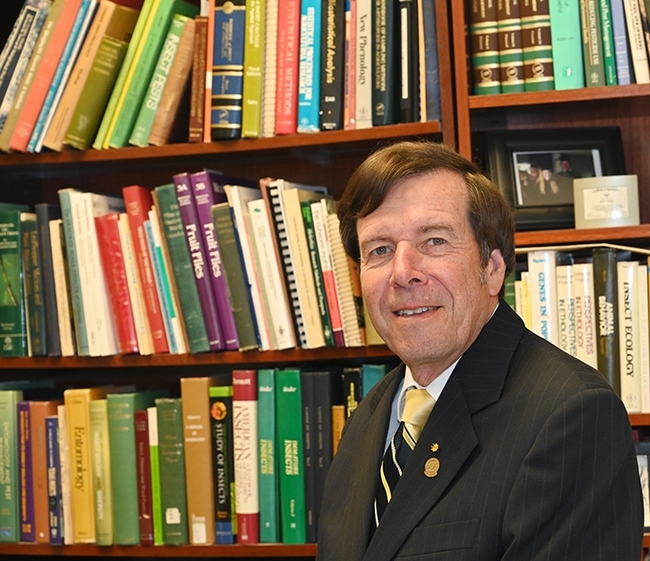
“Playing a role in getting the UC IPM program recognized as an integral part of the university system and gaining its acceptance by growers. But I didn't do this by myself, of course. We had a team of very talented people who were passionate about IPM and worked well together. I was fortunate to help facilitate it and keep the momentum going.”
You studied numerous insects. What's a favorite and why?
“The spotted-wing drosophila is my favorite. There's just so much that can be done with it. It's easy to rear, has a short generation time, and an economic problem. And it's a Drosophila after all, so it brought me back to population genetics, which I enjoyed many years ago. Working with geneticist Joanna Chiu has enabled me to learn about molecular techniques. She's great to work with and is patient with an old guy like me.”
Chiu, who became chair of the UC Davis Department of Entomology and Nematology on July 1, 2023, commented July 6: “Frank has been an amazing and supportive mentor and friend since the day I met him. He welcomed me with open arms into the department when I first started as an assistant professor and introduced me to research in Agricultural Entomology. Given my postdoctoral training in biomedical sciences in the Drosophila model, I must have sounded so naive when we first started our now decade-long collaboration on the fruit pest Drosophila suzukii, but he has always been so patient as a mentor. He is literally a walking encyclopedia; I have learned so much from him and continue to do so every single time I talk to him. I have been so lucky to have Frank as a mentor!"
What does Zalom, as a long-time Extension entomologist, see as the future for Extension? He told Rice: “…I think extension is tremendously important and it is one of the things that has made the land-grant university system unique in the world. Five years ago, I might have said, ‘The future's bleak in California.' And if California's budget problems got really bad, I'm not sure that it would survive. The campus and county links were becoming increasingly strained as retirements were greatly reducing the numbers of specialists and farm advisors, and the ability to respond to problems locally became increasingly difficult. The traditional extension model didn't reflect the current way information is being transferred, either. In California, there are well-established crop consultants that advise growers and large farming operations with their own crop and pest management staffs. Recently, budgets have increased in extension and people are being hired again. But many new positions reflect working on more thematic problems like fire and climate. Roles have shifted for extension, with farm advisors and specialists assuming more of the traditional experiment station applied research role. California extension is in transition.”
Other questions and answers published in the American Entomologist article include:
Do you think the future is bright, but just different?
“I think it is bright, because there remains a need for university-based applied research programs. The traditional extension programs where you'd regularly meet with growers—there's going to be a different model for that. More electronic transfer of information, more electronic meetings, but it loses something.”
What great question in agricultural entomology or agricultural policy would you like to see addressed before you call it quits?
“The biggest challenge is invasive species. Accepting that they will get established and how will you manage them from a practical and policy standpoint. They're probably not going to be eradicated, so less emphasis on eradication and more on management. And dealing with trade issues, which are deeply political. How do we manage invaders on a world scale to keep them out of the chain of trade? I would like to see policymakers address that at some point. But right now, it's a losing battle.”
Any other questions to address?
“Another is the potential for using pesticides on a prescription basis. If an insecticide presents a human health or environmental hazard, maybe somebody should be trained and licensed to prescribe its used safely under less risky circumstances. That's a policy to consider instead of eliminating the ability to use pesticides that have value. Ultimately, too many materials are lost because the ag industry fights use restrictions right to the end. Maybe proposing prescription use is some way of maintaining useful products.”
As president, you issued some Grand Challenges. Do you feel like those gained any traction?
“They got people talking about important issues that the entomological community can address, so in that respect, I think it did. It also helped ESA's global initiative by partnering with other international societies, particularly with the Entomological Society of Brazil. I noticed the Royal Entomological Society has established a Grand Challenges initiative to identify how to improve the human condition.”
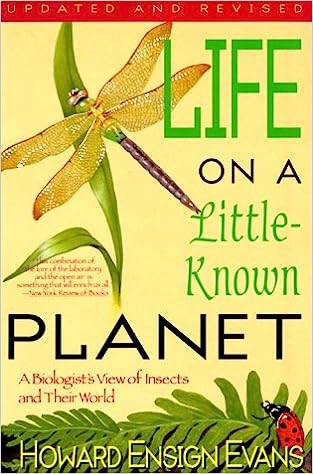
“A good one is Life on a Little-Known Planet: A Biologist's View of Insects and Their World [by Howard Ensign Evans]. It tells why insects are important and the research that led to important discoveries. If you're not interested in that sort of thing, then maybe you shouldn't be studying entomology or pursuing it as a career.
In the Rice interview, Zalom also touched on his family. “Family comes first in my life, then work. I still bring a lot of entomology-related work home with me. Honestly, it's pretty bad. (Laughs). I may have gotten a job in marine biology, but I wouldn't have been any happier.”
Zalom is married to the former Janet Smilanick, who received her master's degree from UC Davis in the 1970s. Her major professor was chemical ecologist Martin Birch (1944-2009), who served on the UC Davis faculty from 1973 to 1981, chairing the department from 1979 to 1981 before accepting a faculty position at the University of Oxford.
The couple married when Janet was Professor Marjorie Hoy's staff research associate at UC Berkeley. Hoy was also featured in an American Entomologist ‘Legends' article in fall 2019. The Zaloms have two children (Martina, an oncologist and Frank Nicholas “Nick,” a lawyer) and four grandchildren, ranging in age from two months to 11 years.
Neither Martina nor Nick expressed interest in following in their parents' entomological footsteps.
Martina, who received her bachelor of science degree in bioengineering from UC Berkeley and her medical degree from UC San Diego, is an oncologist/hematologist with Kaiser Permanante, Roseville. She served on the staff at Olive View/UCLA Medical Center, Los Angeles, before returning to the Sacramento area about four years ago.
Nick, who received his bachelor of science degree in economics from the U.S. Naval Academy, Annapolis, and his law degree from Georgetown University, Washington, D.C., is a senior associate with the law firm of Orrick, Herrington, and Sutcliffe in Sacramento. Nick served three deployments as an officer in U.S. Navy, doing drug interdiction in central and South America and port security in the Persian Gulf. Like Martina, he also returned to the Sacramento area about four years ago.
Meanwhile, Zalom has added another position to his curriculum vitae: he recently accepted a position with the USDA's National Institute of Food and Agriculture (USDA-NIFA) as Panel Manager for the 1890 Capacity Building Grants Program.
His footprints and legacy in the entomological world continue.



